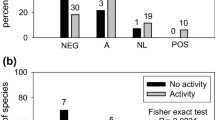Abstract
The influence of temperature on locomotor activity was determined for the sub-Antarctic mites, Halozetes fulvus Engelbrecht and Podacarus auberti Grandjean. In both species walking was severely impaired at below-freezing temperatures. Above zero, locomotor activity rates increased with a rise in temperature over a wide temperature range (for example, this was 2–30°C for H. fulvus), and they showed a biologically normal level of sensitivity to change in temperature. All the calculated Q10 values for mean rates over 5° intervals varied between 1.3 and 2.9. The present data are compared with some rate functions of maritime and continental Antarctic micro-arthropods, and they confirm the relative enhancement of the physiological rate by a continental Antarctic mite. One explanation for the less temperature-sensitive rates in H. fulvus and P. auberti may be that they have relatively more time available for normal biological activity.
Similar content being viewed by others
References
Block W (1981) Terrestrial arthropods and low temperature. Cryobiology 18:436–444
Block W (1984) Terrestrial microbiology, invertebrates and ecosystems. In: Laws RM (ed) Antarctic ecology, vol 1. Academic Press, London New York, pp 163–236
Block W (1985) Ecological and physiological studies of terrestrial arthropods in the Ross Dependency 1984–85. Br Antarct Surv Bull 68:115–122
Block W (1990) Cold tolerance of insects and other arthropods. Philos Trans R Soc London, Ser B: 326:613–633
Block W (1992) An annotated bibliography of Antarctic invertebrates (terrestrial and freshwater). British Antarctic Survey, Cambridge
Block W, Young SR (1978) Metabolic adaptations of the Antarctic terrestrial micro-arthropods. Comp Biochem Physiol 61A:363–368
Burn AJ (1984) Energy partitioning in the Antarctic collembolan Cryptopygus antarcticus. Ecol Entomol 9:11–21
Burn AJ (1986) Feeding rates of the cryptostigmatid mite Alaskozetes antarcticus (Michael). Br Antarct Surv Bull 71:11–17
Burn AJ, Lister A (1988) Activity patterns in an Antarctic arthropod community. Br Antarct Surv Bull 78:43–48
Cannon RJC, Block W (1988) Cold tolerance of micro-arthropods. Biol Rev 63:23–77
Chown SL, Crafford JE (1993) Microhabitat temperatures at Marion Island (46°54′S, 37°45′E). S Afr J Antarct Res 22:51–58
Convey P (1992) Seasonal lipid contents of Antarctic micro-arthropods. Exp Appl Acarol 15:219–231
Convey P (1994a) The influence of temperature on individual growth rates of the Antarctic mite Alaskozetes antarcticus. Acta Oecologia 15:43–53
Convey P (1994b) Growth and survival strategy of the Antarctic mite Alaskozetes antarcticus. Ecography 17:97–107
Cossins AR, Bowler K (1987) Temperature biology of animals. Chapman and Hall, London
Fitzsimons JM (1971) Temperature and three species of Antarctic arthropods. Pac Insects 25:127–135
Marhsall DJ, Newton IP, Crafford JE (1995) Habitat temperature and potential locomotor activity of the continental Antarctic mite, Maudheimia petronia Wallwork (Acari: Oribatei). Polar Biol 15:41–46
Schenker R, Block W (1986) Micro-arthropod activity in three contrasting terrestrial habitats on Signy Island, maritime Antarctic. Br Antarct Surv Bull 71:31–43
Sømme L (1982) Supercooling and winter survival in terrestrial arthropods. Comp Biochem Physiol 73A:519–543
Wallwork JA (1967) Cryptostimata (oribatid mites). In: Gressitt JL (ed) Entomology of the Antarctic (Antarct Res Ser 10). Am Geophys Union, Washington DC, pp 105–122
Walton DWH (1982) The Signy Island terrestrial reference sites. XV. Micro-climate monitoring, 1972–1974. Br Antarct Surv Bull 55:111–126
Author information
Authors and Affiliations
Rights and permissions
About this article
Cite this article
Marshall, D.J., Chown, S.L. Temperature effects on locomotor activity rates of sub-Antarctic oribatid mites. Polar Biol 15, 47–49 (1995). https://doi.org/10.1007/BF00236123
Received:
Accepted:
Issue Date:
DOI: https://doi.org/10.1007/BF00236123




